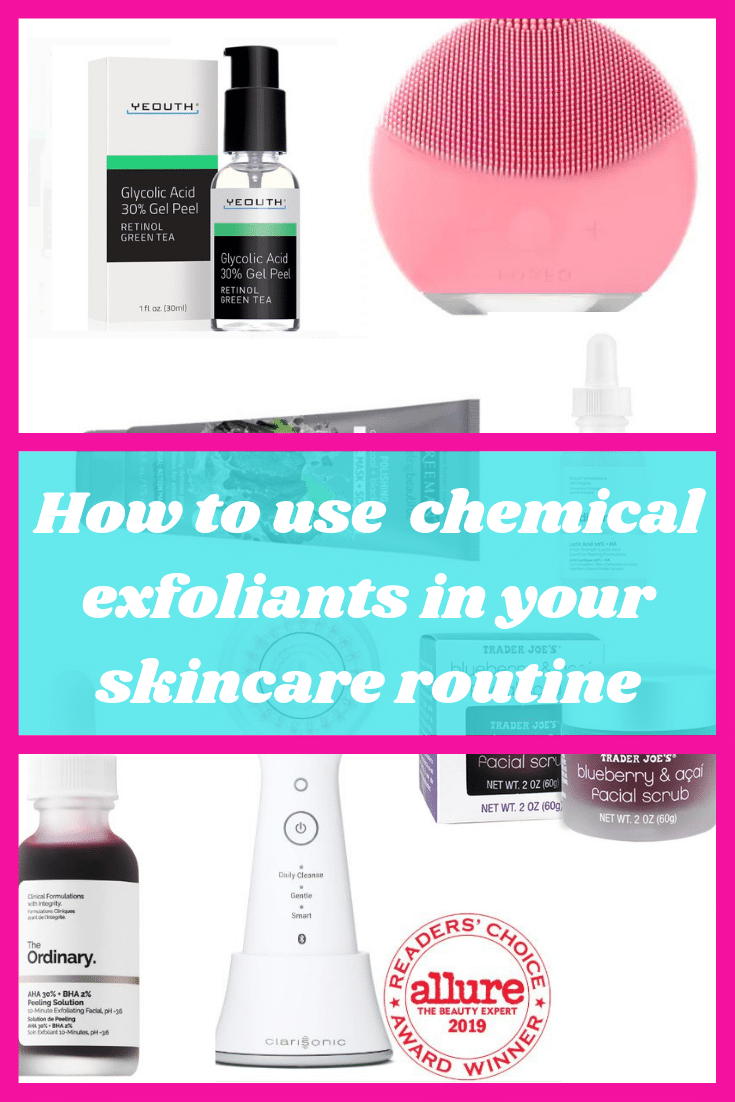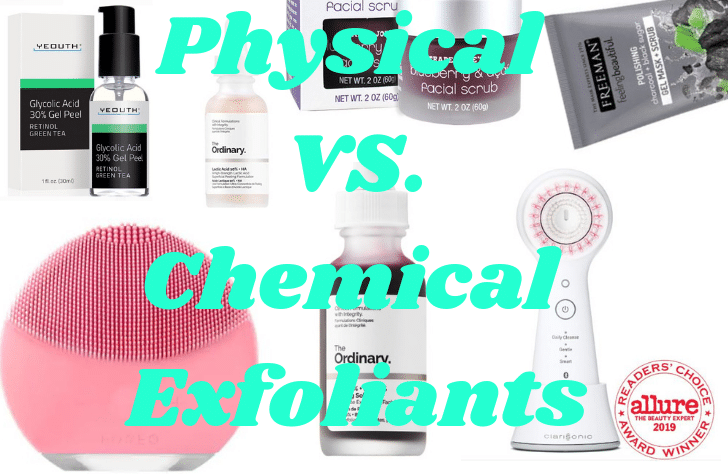Exfoliation is an essential skincare routine step for glowing skin but how often can you use physical and chemical exfoliants? And can you safely use them together at the same time? Here’s the full breakdown!

Can you use a physical and chemical exfoliant at the same time?
Chemical and physical exfoliants should not both be used on the same day! You can alternate using a chemical and physical exfoliant from day to day but using both at the same time is a sure-fire way to strip your skin and can even damage your skin barrier. If you want to learn more about protecting your skin barrier, check out my explanation here.
If I’ve neglected my skin, I’ll use a physical exfoliant a day or two before using a chemical exfoliant to get the worst of the dead skin buildup out of the way. This preps my skin to get the full benefits of the acid especially when I’ve gone quite a while between exfoliating sessions.
How to tell if you’ve over exfoliated your skin
Healthy exfoliation gently removes excess dead skin cells from the topmost layer of the skin. If you exfoliate too often, too aggressively, or use multiple products in one day it’s very easy to over-exfoliate the top layer of the skin and expose very young skin cells that are not ready to be out and about.
If your skin has started to feel tight, looks shiny but not oily, or has become overly sensitive or reddened, you probably need to scale back your exfoliation routine. If the products you’re using make your skin feel tight you may actually be damaging your skin barrier a.k.a acid mantle. Check out my full guide on how to stop damaging your skin here!
This post contains affiliate links; if you snag a deal through my link it will send some spare change my way to keep this slice of the internet up and running.
Can you chemically exfoliate every day?
No, please don’t! Most skin types can exfoliate around two to three times a week. People with hypersensitive skin should start by exfoliating only once or twice a week. You can slowly build up to exfoliating more often once you give your skin a chance to adjust if you feel like you’re not getting enough.
It’s also extremely important to properly moisturize your skin between exfoliation sessions. I recommend using a hydrating sheet mask or a sleeping mask every few days. If you need help picking one out check out my guide on how to find the best mask for your skin type here.
For example, I have combination skin and I exfoliate three times a week. Here’s what my skincare schedule currently looks like:
- Sunday: Normal Skincare Routine
- Monday: Physical Exfoliant (I’ve been using the Trader Joe’s Blueberry and Acai Facial Scrub or I also really like the Freeman Charcoal + Black Sugar Mask)
- Tuesday: Moisturizing Sheet Mask or Sleeping Mask
- Wednesday: Chemical Exfoliant like The Ordinary AHA 30% + BHA 2% Peeling Solution.
- Thursday: Normal Skincare Routine
- Friday: Chemical Exfoliant
- Saturday: Moisturizing Sheet Mask or Sleeping Mask
What is the difference between physical and chemical exfoliants?
Chemical exfoliants acids help dissolve the connections between skin cells so they can be shed from the surface of the skin. Typically you apply a thin layer of the acid and let it sit 2-3 minutes before rinsing it off with cold water to stop the chemical reaction. Always carefully read the instructions before using a new skincare product! It’s also a good idea to patch test chemical exfoliants before use to make sure they are not too strong for your skin type.
On the other hand, physical exfoliators use gritty ingredients like sugar or jojoba beads or a facial brush to buff the skin’s surface and physically remove dead skin cells.

Is chemical exfoliation better than physical?
It’s easy to go overboard while you’re scrubbing away with a physical exfoliant. In a perfect world, you would apply the same amount of pressure in every area of your face while using your scrub but most people tend to scrub more aggressively in problem areas and neglect the rest of the face.
Chemical exfoliants are applied in a thin layer over the entire face and ensure an even level of exfoliation. I personally prefer using chemical exfoliants like lactic acid and glycolic acid over a standard facial scrub or brush.
Cult classic facial brushes like the Clairsonic and FOREA Luna go for $100+ and give the same results as chemical exfoliants but you also have to deal with replacing brush heads and charging their batteries. I will always go the chemical exfoliant or scrub route instead of using a facial brush.
It can also be difficult to keep facial brush heads clean between uses. Silicone models like the FOREA Luna aren’t too difficult to keep sanitary because you can easily scrub or wipe down the silicone.
Do chemical exfoliants cause sun sensitivity?
Studies have found that AHA’s (like glycolic acid or lactic acid) increases the chance of sunburn and photosensitivity. Be sure to slather on the SPF after using your go-to chemical exfoliant.
On the other hand, studies show that salicylic acid can act as a sunscreen! Some salicylic acid derivatives like octyl salicylate are sunscreen ingredients – the salicylate part absorbs UV light and stops it from damaging the deeper layers of the skin. (source 1 2) Now, this isn’t to say you can skip out on the sunscreen when using salicylic acid, it just isn’t going to cause any photosensitivity like most chemical exfoliants.
What’s the best kind of exfoliant for acne-prone skin?
I highly recommend BHA chemical exfoliants for acne-prone skin. Physical scrubs remove the top layer of dead skin cells but the acids in chemical exfoliants actually work into clogged pores to treat trapped oil and sebum.
Physical scrubs can help to reduce acne but the active ingredients in an acid peel will actually get to the root of the cause.
My favorite treatment is The Ordinary’s AHA 30% + BHA 2% Peeling Solution. It’s super affordable at $7.20 for 1 oz of product and I’ve seen instant results from this powerful peeling mask.
What’s the best kind of chemical exfoliant for combination skin?
I have combination skin and love using lactic acid treatments. An easy way to incorporate a chemical exfoliant into your everyday skincare routine is to use a milder serum instead of a rinse-off treatment. The Ordinary is my hands down favorite brand for these kinds of serums because they have amazing prices and extremely high-quality formulations.
Their 10% Lactic Acid + HA serum is only $6.80 at Sephora; you just can’t beat that price point. This serum is great for all skin types except for sensitive skin.
Can sensitive skin types use chemical exfoliants?
PHAs are a godsend for sensitive skin types that would like to jump on the chemical exfoliant wagon.
They are both an exfoliant and a humectant wrapped in one! This means that it helps to moisturize the skin while exfoliating which makes it perfect for sensitive skin. I personally love Swanicoco’s PHA Black Sugar Peeling Gel which you can find here.
PHAs have a larger molecular structure and don’t penetrate the skin as deeply as other chemical exfoliants like AHAs and BHAs. This might sound like a negative but, it’s actually a great thing for sensitive skin because it means that PHAs work their exfoliating magic more gently than other types of chemical exfoliants.
What’s your favorite exfoliation product? Let me know in the comments!
Recent Posts
There are two new sunscreens on the block and the lovely folks over at Kinfield gifted some tubes for me to to test out so I can share a skincare deep dive with y'all! This post contains affiliate...
Trying to find a sunscreen formulated without glycerin is no easy task! I've researched hundreds of sunscreen formulas while writing for this blog and it's shocking how extremely few glycerin-free...
